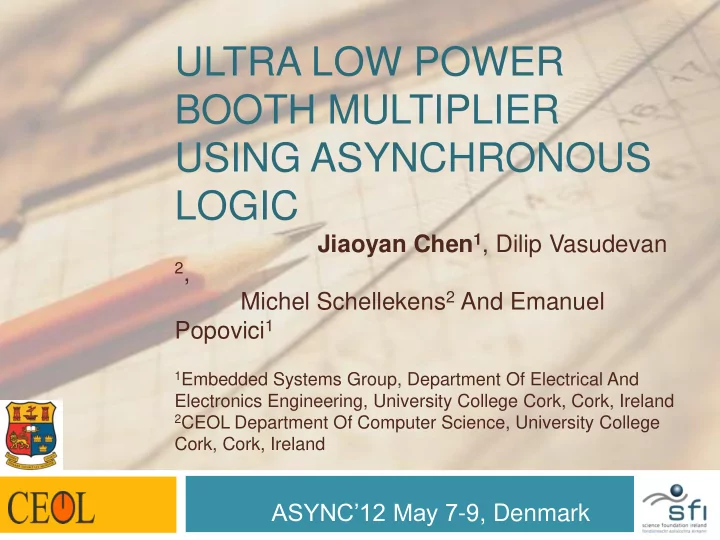

ULTRA LOW POWER BOOTH MULTIPLIER USING ASYNCHRONOUS LOGIC Jiaoyan Chen 1 , Dilip Vasudevan 2 , Michel Schellekens 2 And Emanuel Popovici 1 1 Embedded Systems Group, Department Of Electrical And Electronics Engineering, University College Cork, Cork, Ireland 2 CEOL Department Of Computer Science, University College Cork, Cork, Ireland ASYNC’12 May 7 -9, Denmark
Contents Motivation Background – Booth Multiplier Positive Feedback Charge Sharing Logic General Operation Power Estimation PFCSL Booth Multiplier Results (Power, Area) Conclusion & Future Work ASYNC’12 May 7 -9, Denmark
Motivation Low Power Requirement in Embedded Systems Dynamic Lower Voltage Supply, Avoid Unwanted Switches, Adiabatic Logic Power and etc. Static Power Gating, Multi-threshold and etc. Power Target: Low Power Parallel Multiplier ( Booth Radix-4 Array Multiplier) ASYNC’12 May 7 -9, Denmark
Background – Booth Multiplier Structure Partial Product Generator Adder Block Array-Based Regular Architecture Balanced Capacitive Distribution ASYNC’12 May 7 -9, Denmark
PositiveFeedbackChargeSharingLogi c PFCSL= PFAL (Positive Feedback Adiabatic Logic) + Charge Sharing Technology PFCSL VS PFAL Power DC Supply (No overhead of Specifically designed Power Clock power clock network) Clock Energy ~50% ~60% Recycling Speed Run @ 100MHz Not Efficient in High-Speed Applications ASYNC’12 May 7 -9, Denmark
PositiveFeedbackChargeSharingLogi c General Operation 1) VPC(i) to VDD, VPC(i-1) to Ground. 2) VPC(i) Shares the ENERGY with VPC(i+1), meeting @ VDD/2 3) VPC(i+1) to VDD, VPC(i) to Ground. ASYNC’12 May 7 -9, Denmark
PositiveFeedbackChargeSharingL ogic Power Estimation Charge Sharing Q CV CV C V 1 1 1 2 2 2 Due to the Balanced Distribution, ~50% Energy transferred from one stage to the next. ASYNC’12 May 7 -9, Denmark
Signal Transition Diagram Four-Phase PFCSL Handshaking Handshaking Model Model Controlled by C- Controlled by element Dynamic-AND Ctrl1 Ctrl1 Ctrl2 Ctrl2 Ctrl3 Ctrl3 Ctrl4 Ctrl4 ASYNC’12 May 7 -9, Denmark
Two Controlled Latch Normal D-Latch is NOT suitable in PFCSL circuits. Two Controlled Latch is introduced. Sharing ASYNC’12 May 7 -9, Denmark
PFCSL Booth Multiplier Only ONE set of Y(i) is fetched at each time. Smaller Area Lower Power ASYNC’12 May 7 -9, Denmark
Results Comparison – ADDER One-Bit Full Adder (VDD=1V, 45nm TSMC) Spee Static Dynam PFAL PFCSL (Non- d ic Adiabatic) 100M 325n 550nW 520nW 266nW Hz W 20% 52% 49% / ~ Static Power Dynamic Power ASYNC’12 May 7 -9, Denmark
Results Comparison – Multiplier Static Power Dynamic Power ASYNC’12 May 7 -9, Denmark
Results Comparison – Multiplier Area Comparison (Transistor Numbers) PPG Communicati Adders Latches Total on Circuits PFCSL 1830 280 6231 4300 12641 STATIC 6544 154 6952 3440 17090 ASYNC’12 May 7 -9, Denmark
Conclusion & Future Work New Logic family – PFCSL New structure of PPG, Booth Multiplier Power and area improvements In the future, implement into 8051 microcontroller design. Fabricate it!!! ASYNC’12 May 7 -9, Denmark
Acknowledgements This work was funded by the Science Foundation Ireland under Grant number 07/IN.1/1977. The authors also would like to thank Synopsys, Ireland for their generous support in this project. ASYNC’12 May 7 -9, Denmark
Thank you ! Questions ? ASYNC’12 May 7 -9, Denmark
Recommend
More recommend